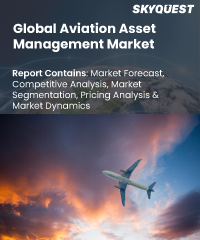
Report ID: SQMIG20A2145

Report ID:
SQMIG20A2145 |
Region:
Global |
Published Date: March, 2024
Pages:
202
|
Tables:
90 |
Figures:
76
Aviation Asset Management Market size was valued at USD 229.21 billion in 2022 and is poised to grow from USD 240.44 billion in 2023 to USD 352.54 billion by 2031, growing at a CAGR of 4.90% during the forecast period (2024-2031).
The Global Aviation Asset Management Market is a thriving and dynamic industry that plays a vital role in ensuring the efficient and effective management of aviation assets throughout their lifecycle. This market revolves around the strategic planning, acquisition, operation, maintenance, and disposal of aircraft, engines, and other aviation assets. The purpose of the Aviation Asset Management market is to optimize the utilization, performance, and value of aviation assets for airlines, leasing companies, manufacturers, and other stakeholders in the aviation industry. It involves the comprehensive management of assets to enhance operational efficiency, minimize downtime, reduce costs, and maximize returns on investment. Several drivers contribute to the growth of the Aviation Asset Management market. Firstly, the rapid expansion of the global aviation industry, coupled with the increasing demand for air travel, drives the need for efficient asset management practices. Airlines and leasing companies aim to maximize the utilization of their fleets, improve maintenance planning, and optimize asset lifecycle management to meet the growing demand. Furthermore, the emergence of new aircraft models, technological advancements, and the need for compliance with stringent regulatory standards create opportunities for asset upgrades, fleet modernization, and replacement strategies. The drive for fuel efficiency, environmental sustainability, and cost savings also encourages the adoption of advanced asset management solutions. However, the Aviation Asset Management market does face certain restraints. The high costs associated with aircraft acquisition, maintenance, and storage, coupled with economic uncertainties and volatile fuel prices, pose challenges for market growth. Additionally, the complex regulatory environment, geopolitical factors, and cyclical nature of the aviation industry can impact asset management strategies.
Key trends in the Aviation Asset Management market include the adoption of digital technologies such as IoT, big data analytics, and artificial intelligence for real-time monitoring, predictive maintenance, and optimization of asset performance. The shift towards outcome-based contracts, where asset management providers offer comprehensive services based on performance metrics, is also gaining traction. Additionally, the focus on sustainability and environmental responsibility drives the integration of eco-efficient practices and the consideration of lifecycle environmental impacts in asset management decisions. Amidst the challenges and trends, the Aviation Asset Management market offers significant opportunities. The growing demand for aircraft leasing, the rise of low-cost carriers, and the need for fleet optimization in emerging markets present attractive avenues for market expansion. Moreover, the ongoing digital transformation and the integration of advanced technologies create opportunities for innovative asset management solutions and services.
US Aviation Asset Management Market is poised to grow at sustainable CAGR for the next forecast year.
Our industry expert will work with you to provide you with customized data in a short amount of time.
REQUEST FREE CUSTOMIZATIONWant to customize this report? This report can be personalized according to your needs. Our analysts and industry experts will work directly with you to understand your requirements and provide you with customized data in a short amount of time. We offer $1000 worth of FREE customization at the time of purchase.

Report ID: SQMIG20A2145